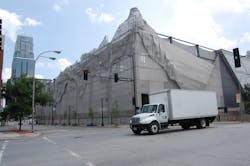The “re-urbanization” trend accelerating across much of the U.S., combined with the ongoing capacity crunch and driver shortage in the trucking industry, is fostering more demand for “last mile” or “white glove” styled custom delivery services – demand that’s only expected to increase in 2015.
“We’re seeing many TL and LTL companies diversifying into this [last mile] space – creating customized divisions to provide such ‘white glove’ or customized delivery services,” Ken Wood, executive VP-product management at Descartes Systems Group, explained to Fleet Owner.
“Part of what’s driving this is not only demand by both businesses and consumers for more time-definite delivery service but to help [carriers] create more attractive jobs for truck drivers,” he added. “This is a way to offer drivers not only more pay but more home time as well.”
Wood also noted that providing such higher-level delivery service also ties carriers and shippers more closely together, meaning it makes carriers much harder to be displaced.
“It’s a very different world, where the shipper and carrier are far more ingrained with one another through technology,” he pointed out.
Specialty mattress retailer Sleepy’s, for example, recently deployed Descartes' home delivery appointment booking and mobile solutions to better appeal to its retail customer base.
“A huge differentiator for us is the ability to collaborate with our independent delivery agents to support the entire customer buying and delivery lifecycle,” said Donald Rowley, CIO at Sleepy's, in a statement, noting that company ships its products from seven distribution centers located throughout the country and delivers an average of over 3,000 mattresses every day.
Bradley Jacobs, chairman and CEO of XPO Logistics, touched on some of the same reasoning regarding his company’s $26.6 million purchase of Optima Service Solutions back in late 2013.
“[The Optima acquisition] expands the capabilities of our last-mile division, XPO Last Mile. It enhances our ability to provide a seamless in-home delivery experience for end customers, particularly with large appliances and electronics,” he noted.
Jacobs added that another “powerful tailwind” driving the “custom delivery” sector is the growing inclination of retailers and manufacturers to outsource the last-mile logistics of heavy goods.
John Larkin, managing director & head of transportation capital markets research for Wall Street investment firm Stifel Nicolaus & Co., added that the “re-urbanization” of America combined with growing e-commerce activity for all manner of goods is going to make such “last mile” delivery service a “much bigger factor” in the freight transportation world.
“Many people are making their purchases with a handheld device and are scheduling an appointment for the delivery of whatever it is they ordered at 10 in the morning for 3 in the afternoon,” he explained in a presentation last year. “That is the way the world is developing and it is going to be very interesting to see how the brick and mortar based retailers respond to this trend.”
Larkin noted that for the world as a whole 53% of the population lived in a city in 2012. In the U.S., they are referred to as “SMSAs,” short for “Standard Metropolitan Statistical Areas,” as they include the suburbs, and 83% of U.S. population resided in them two years ago, up from 75% in 1990.
“This is probably going to continue to grow,” he said. “There is really not a whole lot going on in small town America [as] the agricultural business has become almost industrialized. With technology, there is no reason for a lot of people to be out there on the farm. We have machinery to do that kind of work.”
Alongside tis increasingly urbanized environment in the U.S. is a major change in family unit composition, Larkin pointed out, which is leading to big changes in freight transportation.
“This world of delayed marriages and smaller families has a big effect on the economy,” he said. “[With big families], usually, there is a long commute to work. Often there is a big house that consumes a lot of energy; that needs to be painted; that needs furniture; that needs a lot of floor coverings, window treatments, etc. All this generates freight.”
Yet now the America we are moving towards, Larkin emphasized, is comprised of people who live in places like Fells Point in downtown Baltimore, walking past the inner harbor on the way to the office, and walking back at night.
“Maybe eventually he or she walks past some kind of a UPS store where they pick up something they ordered at 10 in the morning and is there waiting for them in a locker after work,” Larkin added.
“These are younger, well educated people. They do not commute a long distance. They are not driving by malls and supermarkets every day. They live, eat, work, and play all in the same place. They marry later, if at all, and they have fewer children,” he stressed. “It is a different world.”
About the Author
Sean Kilcarr
Editor in Chief
Sean Kilcarr is a former longtime FleetOwner senior editor who wrote for the publication from 2000 to 2018. He served as editor-in-chief from 2017 to 2018.
